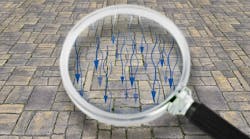About the author: Deb Colbert, P.E., is an environmental engineer with Vari-Tech. Colbert can be reached at [email protected] or 978.887.0272.
Last summer, Texas experienced one of its worst droughts ever and had “water restrictions enforced,” according to signage across the state. Homeowners could water twice a week, between 8 p.m. and 4 a.m., and commercial properties could only water once a week. In the Northeast, signs appear every June and delineate between a “voluntary” water ban and a “mandatory” one. This is happening all across the U.S.
Water is a precious resource that we all take for granted. It is time to think greener and use innovative green technologies to save money and keep grass green without compromising communities’ water supplies.
Creating Savings
Vari-Tech and Stark Environmental worked together to design a rainwater harvesting system in Dallas. The client, Metro Media Place, wanted to capture the roof runoff and use it to water its gardens and plants. The site is a large commercial building where the roof runoff is collected into two concrete stilling basins that remove solids prior to entering the underground tank. These basins then feed a PVC-lined Brentwood StormTank System. By installing the rainwater harvesting system, the owner saves in two ways: It reduces consumption of city water and therefore reduces the owner’s water bill, and the owner receives a discounted water rate from the city of Dallas for using green technology.
System Installation
The site was excavated and bedding material was brought in and mechanically compacted to the proper elevation. The excavation, tank assembly and tank installation were completed in two days. Vari-Tech provided a field specialist to seam the liner and boots as part of the package. This system’s capacity is 3,981 cu ft or 29,777 gal of storage. The material arrived on pallets and the 304 3-ft-high tank units were assembled using just a simple rubber mallet.
The subgrade consisted of 6 in. of Type I or Type II ASTM D2321 that was mechanically compacted. The PVC liner was sandwiched between two layers of 8-oz non-woven Mirafi filter fabric to protect it during the installation of the tanks and during the backfilling. The tanks then were placed in the excavated area. The liner and fabric were pulled up and over the tanks. Another sheet of liner was placed on top of the system and glued in place.
All of the penetrations were booted. The boots were made specifically for the outside diameter of the pipe penetrations and seamed to the main liner. Cleanouts were installed in two locations on the system. The cleanouts consisted of high-density polyethylene (HDPE) pipe with an HDPE plate welded at the base. These cleanouts run to grade and have access at the surface. This allows for future televising of the system and maintenance (flushing and vacuuming), should the inspection indicate that cleaning is warranted. The 97% void space and openness of the units lends itself to maintenance, should it be required. Upstream solids removal is always recommended for these types of systems.
Going Green
The contractor was able to water the newly planted landscaping with water from the rainwater harvesting system. A second connection to the city’s water supply ensures an irrigation water source during periods of no rainfall. The system lies under a concrete paved parking lot. With 2 ft of cover, the tanks will handle HS-25 loads, or a 40,000-lb-per-single-axle load.
The standard Brentwood StormTank module is 18 in. wide and 3 ft long; the height varies from 18 to 36 in., in 6-in. increments. In addition, the tanks can be stacked to 6 ft of height. The tank has a 97% void space, which is excellent for areas with limited space and also reduces the excavated footprint. This system is very versatile. It can be used for infiltration or, as in the Dallas project, wrapped in a liner to be used for rainwater harvesting or detention.
As urban areas develop, engineers should consider reuse options to preserve this precious resource and go green.


